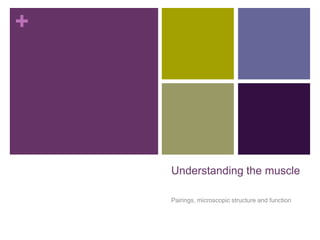Discoving the muscle
- 1. + Understanding the muscle Pairings, microscopic structure and function
- 2. + Understanding the muscle ïŪ Muscles never work on their own, and always work in teams. ïŪ A muscle belly will have tendons at either end to attach them to bone ïŪ A muscle is always attached to 2 or more bones (by tendons) to allow a stable and strong surface to pull against. These connections are called the origin and insertion.
- 3. + Muscle connections to bones Origin ïŪ Is the place where the muscle is attached to the most stable surface â which is usually a flat bone such as the scapula or pelvic girdle. ïŪ This provides the muscle with a strong surface to pull against Insertion ïŪ Is at the other end of the muscle at attached to the bone where the movement occurs.
- 4. + Origin and insertion example ïŪ Bicep ïŪ Its origin is at the scapula and insertion is the radius ïŪ So when the bicep shortens, the lower arm (including the radius) will move towards its origin
- 5. + Reciprocal inhibition ïŪ When muscles on one side of a bone or joint relax to accommodate contraction on the other side of the bone or joint ïŪ Biceps and triceps ïŪ Quads and Hamstrings ïŪ Gastrocnemius and tibialis anterior
- 6. + Agonist â Antagonist relationship ïŪ Muscles always work in pairs ïŪ The agonist is the muscle primarily responsible for producing a movement ïŪ The antagonist is the muscle which relaxes while the movement takes place to prevent injury ïŪ When a muscle contracts, it is critical for the muscle which performs the opposite movement to relax to prevent an injury occurring (muscle tear)
- 7. + Stabilisers ïŪ Provide stability to the origin so maximal contraction force can be applied. ïŪ EXAMPLE: During elbow flexion the trapezius contracts to stabilise the scapula and provide a strong, rigid base for the bicep to pull on.
- 8. + Inside the Muscle Belly Microscopic structure of a muscle
- 9. + The structures ïŪ The muscle belly consists of thousands of muscle fibres known as fascicles which run side by side along the length of the muscle ïŪ Each of these fibres is encased in and surrounded by connective tissue known as perimysium, which assists in keeping the fascicles together.
- 11. + Muscle Fibres ïŪ Each fascicle is made up of several muscle fibres, which are made up of even smaller fibres called myofibrils, which are similar to the many wires within a telephone cable. These have many units, known as sarcomeres, which are arranged end to end for their entire length of the myofibril
- 12. + The Sarcomere ïŪ Is a contractile unit, and each end is designated by a line called a Zline. ïŪ Each sarcomere consists of two proteins myofilaments called actin and myosin. ïŪ Actin is a thin filament which is attached to the Z-line ïŪ Myosin is a thick filament which is situated between each of the actin filaments
- 13. The Lines and Zones of a Sarcomere +
- 14. + The Lines and Zones of a Sarcomere ïŪ The Z-line: Marks the two ends of a sarcomere ïŪ The I-band: Where only actin is found ïŪ The A-band: Where both actin and myosin are found and equates to the length of the myosin filaments ïŪ The H-zone: Where only myosin is found and is the gap between the ends of the actin
- 15. + A muscle contraction ïŪ The myosin filaments have cross bridges (oar-like structures) that are attracted to the actin filaments ïŪ At rest, there is little contact between the actin and the myosin ïŪ However, when the sarcomere contracts, the cross bridges attach to the actin filaments and pull them into the centre of the sarcomere in a ârowingâ action â ïŪ The cross bridges continue to detach and reattach themselves from the actin filaments, shortening the sarcomere. ïŪ Every sarcomere along the muscle fibre shortens, leading the whole muscle to contract. â ïŪ The muscle will relax when the actin and myosin filaments lose contact with each other that is, when the cross bridges detach from the actin.
- 18. + Muscle Tone ïŪ Not all the myosin filaments detatch themselves from the acti. Some may stay in contact, so the muscle is never completely relaxed. ïŪ If this is the case, the muscle is said to have âtoneâ ïŪ The advantage of muscle tone is that the actin and myosin filaments are always ready to contract

















